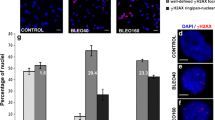Summary
In order to investigate at ultrastructural level the mechanism of DNA synthesis progression during the different moments of S-phase a bromodeoxyuridine-anti bromodeoxyuridine (BrdU-anti BrdU) method has been applied to synchronized 3T3 fibroblasts. After 30 min BrdU incorporation, five different labelling patterns can be identified and should be related to early, middle and late S-phase. These patterns are represented mainly by diffuse labelling localized in different nuclear domains and by quite rare cases in which the labelling is limited to isolated clusters of gold particles. After a 5-min pulse with BrdU it is possible to observe isolated clusters of gold particles at each moment of S-phase, which, however, exhibit the same distribution of the five principal labelling patterns observed after 30 min incorporation. In both cases labelling can be detected in the interchromatin regions during early S-phase, at the boundary between interchromatin and heterochromatin during middle S-phase and in the heterochromatin domains during late S-phase. Considering their size, the isolated spots of labelling could be interpreted as single replication units which are subsequently activated throughout the different moments of the S-phase.
Similar content being viewed by others
References
Berezney R, Coffey DS (1975) Nuclear protein matrix: association with newly synthesized DNA. Science 189:291–293
De Mey J, Moeremans H, Geuens G, Nujdens R, De Brabander M (1981) High resolution light and electron microscope localization of tubulin with the IGS (immunogold staining) method. Cell Biol Int Rep 5:889–899
Fakan S, Hancock R (1974) Localization of newly-synthesized DNA in a mammalian cell as visualized by high resolution autoradiography. Exp Cell Res 83:95–102
Hand R (1975) Regulation of DNA replication on subchromosomal units of mammalian cells. J Cell Biol 64:89–97
Hand R (1978) Eucaryotic DNA: organization of the genome for replication. Cell 15:317–325
Hand R, Tamm I (1974) Initiation of DNA replication in mammalian cells and its inhibition by reovirus infection. J Mol Biol 82:175–183
Hori TA, Lark KG (1974) Autoradiographic studies of the replication of satellite DNA in the kangaroo rat. Autoradiographs of satellite DNA. J Mol Biol 88:221–232
Huberman JA, Riggs AD (1968) On the mechanism of DNA replication in mammalian chromosomes. J Mol Biol 32:327–341
Huberman JA, Tsai A, Deich RA (1973) DNA replication sites within nuclei of mammalian cells. Nature 241:32–36
Jackson DA, Cook PR (1986) Replication occurs at a nucleoskeleton. Eur Mol Biol Organ J 5:1403–1410
Lau YF, Arrighi FE (1981) Studies of mammalian chromosome replication. II. Evidence for the existence of define chromosome replicating units. Chromosoma 83:721–741
Mazzotti G, Rizzoli R, Galanzi A, Papa S, Vitale M, Falconi M, Neri LM, Zini N, Maraldi NM (1990) High-resolution detection of newly synthesized DNA by anti-bromodeoxyuridine antibodies identifies specific chromatin domains. J Histochem Cytochem 38/1:13–22
Nakamura H, Morita T, Sato C (1986) Structural organizations of replicon domains during DNA synthetic phase in the mammalian nucleus. Exp Cell Res 165:291–297
Nakayasu H, Berezney R (1989) Mapping replicational sites in the eucaryotic cell nucleus. J Cell Biol 108:1–11
Nelson W, Pienta KJ, Barrack ER, Coffey DS (1986) The role of the nuclear matrix in the organization and function of DNA. Ann Rev Biophys Chem 15:457–475
Painter RB (1978) Inhibition of DNA replicon initiation by 4-nitroquinoline 1-oxide, adriamycin and ethyleneimine. Cancer Res 38:4445–4449
Painter RB, Young BR (1976) Formation of nascent DNA molecules during inhibition of replicon initiation in mammalian cells. Biochim Biophys Acta 418:146–153
Pardoll D, Volgestein B, Coffey DS (1980) A fixed site of DNA replication in eukaryotic cells. Cell 19:527–536
Tubo RA, Berezney R (1987) Identification of 100 and 150S DNA polymerase alpha-primase megacomplexes solubilized from the nuclear matrix of regenerating rat liver. J Biol Chem 262:5857–5865
Van Dierendonck JK, Keyzer R, Van de Velde CJH, Cornelisse CJ (1989) Subdivision of S-phase by analysis of nuclear 5-bromodeoxyuridine staining patterns. Cytometry 10:143–150
Williams CA, Ockey CH (1970) Distribution of DNA replicator sites in mammalian nuclei after different methods of cell synchronization. Exp Cell Res 63:365–372
Zini N, Mazzotti G, Santi P, Rizzoli R, Galanzi A, Rana R, Maraldi NM (1989) Cytochemical localization of DNA loop attachment sites to the nuclear lamina and to the inner nuclear matrix. Histochemistry 91:199–204
Author information
Authors and Affiliations
Rights and permissions
About this article
Cite this article
Rizzoli, R., Baratta, B., Maraldi, N.M. et al. DNA synthesis progression in 3T3 synchronized fibroblasts: a high resolution approach. Histochemistry 97, 181–187 (1992). https://doi.org/10.1007/BF00267309
Accepted:
Issue Date:
DOI: https://doi.org/10.1007/BF00267309




